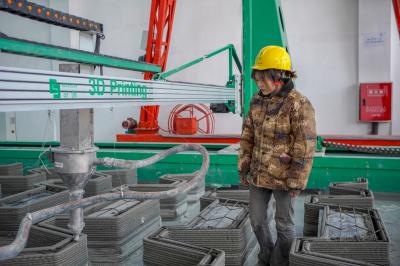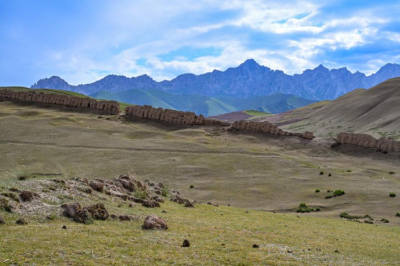Since 2010, the autonomous region has spent more than 6 billion yuan to improve the living environment and the overall environment in 6,223 villages, with positive results. Currently all the major rivers and lakes in Tibet remain in their natural state, 95.7 percent of key waters have reached the national water standards, 97.5 percent of days are rated as “excellent” or “good” in terms of air quality, and ratings of air quality in the Qomolangma region are being maintained at either “excellent” or “good”, with Grade I air quality. VIII. Protecting the Freedom of Religious Belief
It is stipulated in the Constitution of the People’s Republic of China that “No state organ, public organization or individual may compel citizens to believe in, or not to believe in, any religion; nor may they discriminate against citizens who believe in, or do not believe in, any religion.” In Tibet, Tibetan Buddhism, Bon, Islam, and Catholicism coexist with a number of other religions, and within Tibetan Buddhism there are different sects such as Nyingma, Kagyu, Sakya and Gelug. After democratic reform, Tibet put an end to theocracy, separating government from religion and so restoring the latter’s true significance. The freedom of religious belief of all ethnic groups is protected by the Constitution and the laws, with all religions and religious sects being equally respected and protected. This equates to true religious harmony.– Religious activities are held regularly. Currently, Tibet has 1,787 sites for the practice of Tibetan Buddhism, over 46,000 resident monks and nuns, and 358 Living Buddhas. There are four mosques and over 12,000 native Muslims, and one Catholic church and 700 believers. Tibetan and other minority ethnic groups carry out their religious activities in accordance with native traditions. In monasteries of Tibetan Buddhism, traditional religious activities such as learning scriptures and debate, promotion through degrees, initiation as a monk or nun, abhisheka (empowerment ceremony), sutra chanting, and self-cultivation are held on a regular basis, while ceremonial activities are also held at important religious festivals in accordance with local customs. The Tibet Autonomous Region celebrated the 20th anniversary of the enthronement of Chökyi Gyalpo, the 11th Panchen Lama, in 2015, the empowerment ceremony of Kalachakala, and other major Buddhist events. Ordinary believers usually have a scripture room or a Buddhist shrine at home, and such religious activities as circumambulation while reciting scriptures, Buddha worship, and inviting lamas or nuns from monasteries to hold religious rites at home are regularly practiced. The collation and publishing of Buddhist canons in Tibetan and the supply of copies of Kangyur to monasteries have met the study demands of Buddhist monks and nuns and lay believers. – The Living Buddha reincarnation is proceeding well. The Living Buddha reincarnation is a succession system unique to Tibetan Buddhism, and is respected by the state and governments at different levels of the autonomous region. The state issued the Measures on the Management of the Reincarnation of Living Buddhas of Tibetan Buddhism in 2007 to further institutionalize the reincarnation process of Living Buddhas. In 1992 the State Administration for Religious Affairs approved the succession of the 17th Living Buddha Karmapa. Through traditional religious rituals and historical conventions like drawing lots from a golden urn, the search for and identification of the reincarnation of the 10th Panchen Lama was carried out. With the approval of the State Council, the title of 11th Panchen Lama was conferred and he was enthroned in 1995. In 2000 the Seventh Regent Reting Rinpoche was enthroned in accordance with traditional religious rituals and historical conventions; in 2010 the Sixth Living Buddha Dezhub was nominated and enthroned through the drawing of lots from a golden urn and with the approval of the government of Tibet Autonomous Region. By 2018, 91 incarnated Living Buddhas had been confirmed through traditional religious rituals and historical conventions. – The cultivation and training of religious personnel are being strengthened. The system whereby Tibetan Buddhist monks learn sutras has been improved. The government of the Tibet Autonomous Region issued the Opinions on Building a Branch of the Tibetan Buddhist Institute and Methods of Awarding Academic Ranks in the Tibetan Buddhist Institute (trial). The China Tibetan Language High-level Institute of Buddhism has been set up in Beijing, and the Tibetan Buddhist Institute in Lhasa. Both recruit and train senior Buddhist teaching personnel. In November 2011 the Tibetan Buddhist Institute was completed and began operation, following an investment of over 100 million yuan. Since 2005, examinations for senior academic ranks and degree-conferring ceremonies have been held every year at the China Tibetan Language High-level Institute of Buddhism in Beijing, and degree examinations unique to Gelug have been held in Jokhang Temple and the three major monasteries in Lhasa. By 2018, a total of 117 monks had received senior academic titles in Lhasa and 68 in Beijing. – The rights of monasteries and monks are guaranteed. Temples are maintained and protected. Since the 1980s more than 1.4 billion yuan has been spent on restoring Tibetan cultural relics and refurbishing key monasteries. Medium-sized and smaller monasteries, which are not key sites under the state-level protection, are maintained with annual financial support from the regional government. Monastery-run scripture printing houses have been conserved and developed; there are 60 such printing houses at the Potala Palace and other monasteries, producing 63,000 scriptural items every year. Sites for religious activities have been significantly improved and upgraded. All the monks and nuns registered in the autonomous region have been included in the social security net, with full coverage of medical insurance, old-age insurance, subsistence allowance, and personal accident insurance. Monks and nuns are entitled to a free annual health check, with their health records filed and maintained in hospitals. The maintenance of dormitories for monks and nuns in monasteries is included in the government-subsidized housing plans. |
- Home
- News |Tibet |Exclusive |China |World |Related News |Latest
- Documents |White Papers |Others
- Photo |Politics |Economy & Society |Culture & Religion |Human & Nature |Beautiful Tibet |Other Tibetan-Inhabited Area |Exchanges |Related
- Video |News |Documentary |Micro-Video |Entertainment
- Art
- Tourism
- In Focus
- About Tibet






